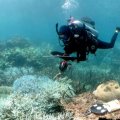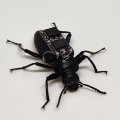The University of Queensland Senate has overwhelmingly approved a new seven-faculty academic structure, to operate from January 1, 1997.
The new structure, approved on September 5, was developed through an iterative consultative process led by Deputy Vice-Chancellor Professor Ted Brown.
Vice-Chancellor Professor John Hay said the change would unify the University's structures and processes for academic decision-making and resource allocation.
Professor Hay said the new structure would provide the University with a better basis for the strategic planning necessary in the next decade and especially in adapting to the challenges and opportunities in Australia's rapidly changing higher education sector.
Senate also received the report of the committee it established to review the role and function of the Academic Board, and reaffirmed the centrality of the Board as the senior academic, deliberative and advisory body to Senate.
Professor Hay said the University had been looking at ways to unify academic decision making and resources allocation for more than a decade and Senate's approval for the new structure could be seen as the culmination of that process.
The specific proposals now approved grew out of a broad consultative process which the Senate initiated three months ago.
Professor Brown circulated a discussion paper for comment on June 19 to the 140-member Academic Board. It was also posted electronically on the University's World Wide Web home page. On July 3, members were sent a summary of issues identified in initial responses and further comment was invited.
A revised discussion paper taking account of the responses was circulated for discussion at the August 19 Academic Board, following which Professor Brown consulted further groups and finalised his proposals for the Vice-Chancellor to take to the Senate for consideration.
Under the restructure, the University's current 16 faculties and six resource groups will be replaced by the seven faculties each led by an executive dean. Each faculty will have a faculty board and faculty executive.
The faculties will be: Arts; Biological and Chemical Sciences; Business, Economics and Law; Engineering, Physical Sciences and Architecture; Health Sciences; Natural Resources, Agriculture and Veterinary Science; and Social and Behavioural Sciences.
Each faculty will comprise groups of the existing academic departments which continue as the basic teaching and research unit, plus related schools, research centres or other specialised facilities.
Within the new faculties, 14 schools will be formed to give a particular focus or identity, typically in the professional areas (for example Law School, Graduate School of Medicine, Dental School). Each school will have an advisory board of studies.
Senate determined that initially, as an interim arrangement, the new executive deans would be appointed wherever possible from the ranks of the current pro-vice-chancellors for the remainder of their contracts, supplemented if necessary by other short-term appointments through internal advertisement.
However the University would move as quickly as possible to appointment through international advertisement, Professor Hay said.
Senate also approved the establishment of a new position of Pro-Vice-Chancellor (Academic), and the following changes of title: Deputy Vice-chancellor to become Senior Deputy Vice-chancellor; Pro-Vice-Chancellor (Research and Postgraduate Studies) to Deputy Vice-Chancellor (Research and Postgraduate Studies).
The Vice-Chancellor was authorised to use the title President in circumstances outside Australia where it more clearly describes his role.
Senate approved the composition of the new faculties as follows:
Arts: Departments of Art History, Asian Languages and Studies, Classics and Ancient History, English, German and Russian Studies, History, Philosophy, Romance Languages, Studies in Religion; School of Music; Centre for Language Teaching and Research; Key Centre for Asian Languages and Studies; University Art Museum.
Business, Economics and Law: Departments of Business Studies, Commerce, Economics, Management; School of Law.
Engineering, Physical Sciences and Architecture: School of Architecture and Planning (Departments of Architecture, Geographical Sciences and Planning); School of Engineering (Departments of Chemical Engineering, Civil Engineering, Electrical and Computer Engineering, Mechanical Engineering, Mining, Minerals and Materials Engineering); School of Information Technology; School of Mathematical and Physical Sciences (Departments of Earth Sciences, Mathematics, Physics); Sir James Foots Institute of Mineral Resources (Departments of Earth Sciences, Mining Minerals and Materials Engineering; Centres - JKMRC, Mined Land Rehabilitation, W.H. Bryan Mining Geology); CMR; Glass Centre; Technology Management Centre; CRCs.
Health Sciences: School of Dentistry; School of Health and Rehabilitation Sciences (Departments of Occupational Therapy, Physiotherapy, Speech Pathology and Audiology); Graduate School of Medicine (Departments of Child Health, Medicine, Obstetrics and Gynaecology, Pathology, Psychiatry, Social and Preventive Medicine, Surgery); School of Pharmacy; ACITHN(UQ) (Nutrition Program, Tropical Health Program); Centre for Health Promotion and Cancer Prevention Research; NRCET.
Biological and Chemical Sciences: Departments of Anatomical Sciences, Biochemistry, Botany, Chemistry, Entomology, Human Movement Studies, Microbiology, Parasitology, Physiology and Pharmacology, Zoology; Brisbane Surface Analysis Facility (CDDD, CMCB, CMM, Heron Island Research Station); CRCs.
Social and Behavioural Sciences: Departments of Anthropology and Sociology, Government, Journalism; School of Education; School of Psychology; School of Social Work and Social Policy.
Natural Resources, Agriculture and Veterinary Science: School of Land and Food Systems (Departments of Agriculture, Animal Production, Food Science and Technology, Management Studies, Plant Production); School of Veterinary Science (Departments of Companion Animal Medicine and Surgery, Farm Animal Medicine and Production, Veterinary Pathology); Central Animal Breeding House; Centre for Integrated Resource Management; Rural Extension Centre; Farm and Veterinary Clinics
For further information contact Professor Hay, (07) 3365 1300.
.jpg)


